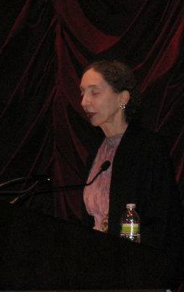 In a fascinating essay on “Inspiration and Obsession in Life and Literature” published in the August 13, 2015 issue of The New York Review of Books, writer (and former JUS conference keynote speaker) Joyce Carol Oates spends a significant amount of time discussing Updike’s debut novel, The Poorhouse Fair, partly in relation to Norman Mailer’s The Naked and the Dead and partly in the context of Toward the End of Time:
In a fascinating essay on “Inspiration and Obsession in Life and Literature” published in the August 13, 2015 issue of The New York Review of Books, writer (and former JUS conference keynote speaker) Joyce Carol Oates spends a significant amount of time discussing Updike’s debut novel, The Poorhouse Fair, partly in relation to Norman Mailer’s The Naked and the Dead and partly in the context of Toward the End of Time:
“John Updike’s first novel, The Poorhouse Fair (1959), published when the author was twenty-six, is a purposefully modest work composed in a minor key; unlike Norman Mailer’s first novel, The Naked and the Dead (1948), also published when the author was twenty-six. Where Mailer trod onto the literary scene like an invading army, with an ambitious military plan, Updike seems almost to have wished to enter by a rear door, claiming a very small turf in rural eastern Pennsylvania and concentrating upon the near-at-hand with the meticulous eye of a poet.
“The Poorhouse Fair is in its way a bold avoidance of the quasi-autobiographical novel so common to young writers: the bildungsroman of which the author’s coming-of-age is the primary subject. Perversely, given the age of the author, The Poorhouse Fair is about the elderly, set in a future only twenty years distant and lacking the dramatic features of the typical future, dystopian work; its concerns are intrapersonal and theological. By 1959 Updike had already published many of the short stories that would be gathered into Olinger Stories, which constituted in effect a bildungsroman, freeing him to imagine an entirely other, original debut work.
“The Poorhouse Fair, as Updike was to explain in an introduction to the 1977 edition of the novel, was suggested by a visit, in 1957, to his hometown, Shillington, which included a visit to the ruins of a poorhouse near his home. The young author then decided to write a novel in celebration of the fairs held at the poorhouse during his childhood, with the intention of paying tribute to his recently deceased maternal grandfather, John Hoyer, given the name “John Hook” in the novel. In this way The Poorhouse Fair both is not, and is, an autobiographical work, as its theological concerns, described elsewhere in Updike’s work, were those of the young writer at the time.
“Appropriately, Updike wrote another novel set in the future near the end of his life, Toward the End of Time (1997), in which the elderly protagonist and his wife appear to be thinly, even ironically disguised portraits, or caricatures, of Updike and his wife in a vaguely postapocalyptic world bearing a close resemblance to the Updikes’ suburban milieu in Beverly Farms, Massachusetts. Is it coincidental that Updike’s first novel and his near-to-last so mirror each other? Both have theological concerns, and both are executed with the beautifully wrought, precise prose for which Updike is acclaimed; but no one could mistake Toward the End of Time, with its bitter self-chiding humor and tragically diminished perspectives, for a work of fiction by a reverent and hopeful young writer. . . .
“The confessional poets—Robert Lowell, John Berryman, W.D. Snodgrass, Anne Sexton, Sylvia Plath, to a degree Elizabeth Bishop—rendered their lives as art, as if self-hypnotized. Of our contemporaries, writers as seemingly diverse as Saul Bellow, Philip Roth, and John Updike created distinguished careers out of their lives, often returning to familiar subjects, lovingly and tirelessly reimagining their own pasts as if mesmerized by the wonder of ‘self.'”
